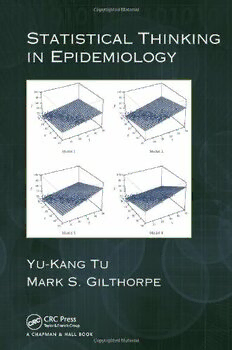
Statistical Thinking in Epidemiology PDF
Preview Statistical Thinking in Epidemiology
Statistics S t a Statistical Thinking Statistical Thinking t i s in Epidemiology t in Epidemiology i c a l While biomedical researchers may be able to follow instructions in T the manuals accompanying statistical software packages, they do h not always have sufficient knowledge to choose the appropriate i statistical methods and correctly interpret their results. Statistical n Thinking in Epidemiology examines common methodological and k i statistical problems in the use of correlation and regression in medical n and epidemiological research: mathematical coupling, regression to g the mean, collinearity, the reversal paradox, and statistical interaction. i n Statistical Thinking in Epidemiology is about thinking statistically E when looking at problems in epidemiology. The authors focus p on several methods and look at them in detail: specific examples i d in epidemiology illustrate how different model specifications can e imply different causal relationships among variables, and model m interpretation is undertaken with appropriate consideration of the i o context of implicit or explicit causal relationships. This book is l intended for applied statisticians and epidemiologists, but can also o be very useful for clinical and applied health researchers who want to g have a better understanding of statistical thinking. y Throughout the book, statistical software packages R and Stata are used for general statistical modeling, and Amos and Mplus are used T u for structural equation modeling. • Yu-Kang Tu G i l t Mark S. Gilthorpe h o r p K10018 e K10018_Cover.indd 1 6/23/11 11:58 AM Statistical Thinking in Epidemiology Statistical Thinking in Epidemiology Yu-Kang Tu Mark S. Gilthorpe CRC Press Taylor & Francis Group 6000 Broken Sound Parkway NW, Suite 300 Boca Raton, FL 33487-2742 © 2012 by Taylor & Francis Group, LLC CRC Press is an imprint of Taylor & Francis Group, an Informa business No claim to original U.S. Government works Version Date: 20110617 International Standard Book Number-13: 978-1-4200-9992-8 (eBook - PDF) This book contains information obtained from authentic and highly regarded sources. Reasonable efforts have been made to publish reliable data and information, but the author and publisher cannot assume responsibility for the validity of all materials or the consequences of their use. The authors and publishers have attempted to trace the copyright holders of all material reproduced in this publication and apologize to copyright holders if permission to publish in this form has not been obtained. If any copyright material has not been acknowledged please write and let us know so we may rectify in any future reprint. Except as permitted under U.S. Copyright Law, no part of this book may be reprinted, reproduced, transmitted, or utilized in any form by any electronic, mechanical, or other means, now known or hereafter invented, including photocopying, microfilming, and recording, or in any information stor- age or retrieval system, without written permission from the publishers. For permission to photocopy or use material electronically from this work, please access www.copy- right.com (http://www.copyright.com/) or contact the Copyright Clearance Center, Inc. (CCC), 222 Rosewood Drive, Danvers, MA 01923, 978-750-8400. CCC is a not-for-profit organization that pro- vides licenses and registration for a variety of users. For organizations that have been granted a pho- tocopy license by the CCC, a separate system of payment has been arranged. Trademark Notice: Product or corporate names may be trademarks or registered trademarks, and are used only for identification and explanation without intent to infringe. Visit the Taylor & Francis Web site at http://www.taylorandfrancis.com and the CRC Press Web site at http://www.crcpress.com Contents Preface.......................................................................................................................xi 1. Introduction......................................................................................................1 1.1. Uses.of.Statistics.in.Medicine.and.Epidemiology.............................1 1.2. Structure.and.Objectives.of.This.Book...............................................2 1.3. Nomenclature.in.This.Book..................................................................5 1.4. Glossary...................................................................................................5 2. Vector Geometry of Linear Models for Epidemiologists........................7 2.1. Introduction............................................................................................7 2.2. Basic.Concepts.of.Vector.Geometry.in.Statistics...............................7 2.3. Correlation.and.Simple.Regression.in.Vector.Geometry.................9 2.4. Linear.Multiple.Regression.in.Vector.Geometry.............................11 2.5. Significance.Testing.of.Correlation.and.Simple.Regression. in.Vector.Geometry..............................................................................12 2.6. Significance.Testing.of.Multiple.Regression.in.Vector. Geometry...............................................................................................14 2.7. Summary...............................................................................................15 3. Path Diagrams and Directed Acyclic Graphs..........................................17 3.1. Introduction..........................................................................................17 3.1. Path.Diagrams......................................................................................17 3.1.1. The.Path.Diagram.for.Simple.Linear.Regression...............18 3.1.1.1. Regression.Weights,.Path.Coefficients.and. Factor.Loadings.......................................................19 3.1.1.2. Exogenous.and.Endogenous.Variables................19 3.1.2. The.Path.Diagram.for.Multiple.Linear.Regression............20 3.2. Directed.Acyclic.Graphs.....................................................................21 3.2.1. Identification.of.Confounders...............................................22 3.2.2. Backdoor.Paths.and.Colliders...............................................23 3.2.3. Example.of.a.Complex.DAG..................................................24 3.3. Direct.and.Indirect.Effects..................................................................25 3.4. Summary...............................................................................................26 4. Mathematical Coupling and Regression to the Mean in the Relation between Change and Initial Value............................................27 4.1. Introduction..........................................................................................27 4.2. Historical.Background........................................................................29 4.3. Why.Should.Change.Not.Be.Regressed.on.Initial.Value?. A.Review.of.the.Problem....................................................................29 v vi Contents 4.4. Proposed.Solutions.in.the.Literature................................................30 4.4.1. Blomqvist’s.Formula...............................................................30 4.4.2. Oldham’s.Method:.Testing.Change.and.Average..............30 4.4.3. Geometrical.Presentation.of.Oldham’s.Method.................32 4.4.4. Variance.Ratio.Test.................................................................32 4.4.5. Structural.Regression.............................................................34 4.4.6. Multilevel.Modelling..............................................................35 4.4.7. Latent.Growth.Curve.Modelling..........................................36 4.5. Comparison.between.Oldham’s.Method.and.Blomqvist’s. Formula.................................................................................................37 4.6. Oldham’s.Method.and.Blomqvist’s.Formula.Answer.Two. Different.Questions.............................................................................38 4.7. What.Is.Galton’s.Regression.to.the.Mean?.......................................39 4.8. Testing.the.Correct.Null.Hypothesis................................................40 4.8.1. The.Distribution.of.the.Correlation.Coefficient. between.Change.and.Initial.Value.......................................41 4.8.2. Null.Hypothesis.for.the.Baseline.Effect.on. Treatment.................................................................................43 4.8.3. Fisher’s.Z-Transformation......................................................43 4.8.4. A.Numerical.Example............................................................44 4.8.5. Comparison.with.Alternative.Methods..............................44 4.9. Evaluation.of.the.Categorisation.Approach.....................................45 4.10. Testing.the.Relation.between.Changes.and.Initial.Values. When.There.Are.More.than.Two.Occasions....................................47 4.11. Discussion.............................................................................................48 5. Analysis of Change in Pre-/Post-Test Studies.........................................51 5.1. Introduction..........................................................................................51 5.2. Analysis.of.Change.in.Randomised.Controlled.Trials...................51 5.3. Comparison.of.Six.Methods...............................................................53 5.3.1. Univariate.Methods................................................................54 5.3.1.1. Test.the.Post-Treatment.Scores.Only....................54 5.3.1.2. Test.the.Change.Scores...........................................54 5.3.1.3. Test.the.Percentage.Change.Scores.......................54 5.3.1.4. Analysis.of.Covariance...........................................54 5.3.2. Multivariate.Statistical.Methods..........................................55 5.3.2.1. Random.Effects.Model...........................................55 5.3.2.2. Multivariate.Analysis.of.Variance........................56 5.5.3. Simulation.Results..................................................................59 5.6. Analysis.of.Change.in.Non-Experimental.Studies:.Lord’s. Paradox..................................................................................................60 5.6.1. Controversy.around.Lord’s.Paradox....................................62 5.6.1.1. Imprecise.Statement.of.Null.Hypothesis.............62 5.6.1.2. Causal.Inference.in.Non-Experimental. Study.Design............................................................63 Contents vii 5.6.2. Variable.Geometry.of.Lord’s.Paradox..................................64 5.6.3. Illustration.of.the.Difference.between.ANCOVA. and.Change.Scores.in.RCTs.Using.Variable.Space. Geometry.................................................................................65 5.7. ANCOVA.and.t-Test.for.Change.Scores.Have.Different. Assumptions.........................................................................................65 5.7.1. Scenario.One:.Analysis.of.Change.for.Randomised. Controlled.Trials.....................................................................67 5.7.2. Scenario.Two:.The.Analysis.of.Change.for. Observational.Studies............................................................69 5.8. Conclusion.............................................................................................71 6. Collinearity and Multicollinearity............................................................73 6.1. Introduction:.Problems.of.Collinearity.in.Linear.Regression.......73 6.2. Collinearity...........................................................................................76 6.3. Multicollinearity..................................................................................77 6.4. Mathematical.Coupling.and.Collinearity........................................79 6.5. Vector.Geometry.of.Collinearity.......................................................79 6.5.1. Reversed.Relation.between.the.Outcome.and. Covariate.due.to.Collinearity................................................80 6.5.2. Unstable.Regression.Models.due.to.Collinearity...............81 6.5.3. The.Relation.between.the.Outcome–Explanatory. Variable’s.Correlations.and.Collinearity.............................82 6.6. Geometrical.Illustration.of.Principal.Components.Analysis. as.a.Solution.to.Multicollinearity.......................................................84 6.7. Example:.Mineral.Loss.in.Patients.Receiving.Parenteral. Nutrition................................................................................................85 6.8. Solutions.to.Collinearity.....................................................................89 6.8.1. Removal.of.Redundant.Explanatory.Variables..................89 6.8.2. Centring...................................................................................89 6.8.3. Principal.Component.Analysis.............................................90 6.8.4. Ridge.Regression.....................................................................93 6.9. Conclusion.............................................................................................94 7. Is ‘Reversal Paradox’ a Paradox?.................................................................97 7.1. A.Plethora.of.Paradoxes:.The.Reversal.Paradox..............................97 7.2. Background:.The.Foetal.Origins.of.Adult.Disease. Hypothesis.(Barker’s.Hypothesis).....................................................98 7.2.1. Epidemiological.Evidence.on.the.Foetal.Origins. Hypothesis...............................................................................99 7.2.2. Criticisms.of.the.Foetal.Origins.Hypothesis....................100 7.2.3. Reversal.Paradox.and.Suppression.in.Epidemiological. Studies.on.the.Foetal.Origins.Hypothesis........................102 7.2.4. Catch-Up.Growth.and.the.Foetal.Origins. Hypothesis.............................................................................104 viii Contents 7.2.5. Residual.Current.Body.Weight:.A.Proposed. Alternative.Approach...........................................................107 7.2.6. Numerical.Example..............................................................108 7.3. Vector.Geometry.of.the.Foetal.Origins.Hypothesis.....................109 7.4. Reversal.Paradox.and.Adjustment.for.Current.Body.Size:. Empirical.Evidence.from.Meta-Analysis........................................111 7.5. Discussion...........................................................................................112 7.5.1. The.Reversal.Paradox.and.the.Foetal.Origins. Hypothesis.............................................................................112 7.5.2. Multiple.Adjustments.for.Current.Body.Sizes.................115 7.5.3. Catch-Up.Growth.and.the.Foetal.Origins.Hypothesis....116 7.6. Conclusion...........................................................................................117 8. Testing Statistical Interaction...................................................................119 8.1. Introduction:.Testing.Interactions.in.Epidemiological. Research..............................................................................................119 8.1. Testing.Statistical.Interaction.between.Categorical.Variables.....121 8.2. Testing.Statistical.Interaction.between.Continuous.Variables....124 8.3. Partial.Regression.Coefficient.for.Product.Term.in. Regression.Models.............................................................................128 8.4. Categorization.of.Continuous.Explanatory.Variables..................130 8.5. The.Four-Model.Principle.in.the.Foetal.Origins.Hypothesis......131 8.6. Categorization.of.Continuous.Covariates.and.Testing. Interaction...........................................................................................132 8.6.1. Simulations............................................................................132 8.6.2. Numerical.Example..............................................................133 8.7. Discussion...........................................................................................134 8.8. Conclusion...........................................................................................137 9. Finding Growth Trajectories in Lifecourse Research..........................139 9.1. Introduction........................................................................................139 9.1.1. Example:.Catch-Up.Growth.and.Impaired.Glucose. Tolerance................................................................................140 9.1.2. Galton.and.Regression.to.the.Mean...................................141 9.1.3. Revisiting.the.Growth.Trajectory.of.Men.with. Impaired.Glucose.Tolerance................................................144 9.2. Current.Approaches.to.Identifying.Postnatal.Growth. Trajectories.in.Lifecourse.Research.................................................146 9.2.1. The.Lifecourse.Plot...............................................................147 9.2.2. Regression.with.Changes.Scores........................................150 9.2.3. Latent.Growth.Curve.Models.............................................151 9.2.4. Growth.Mixture.Models......................................................159 9.3. Discussion...........................................................................................162 Contents ix 10. Partial Least Squares Regression for Lifecourse Research.................165 10.1. Introduction........................................................................................165 10.2. Data......................................................................................................166 10.3. OLS.Regression..................................................................................166 10.4. PLS.Regression...................................................................................167 10.4.1. History.of.PLS.......................................................................167 10.4.2. PCA.Regression.....................................................................170 10.4.3. PLS.Regression......................................................................171 10.4.4. PLS.and.Perfect.Collinearity...............................................172 10.4.5. Singular.Value.Decomposition,.PCA.and.PLS. Regression..............................................................................173 10.4.6. Selection.of.PLS.Component...............................................176 10.4.7. PLS.Regression.for.Lifecourse.Data.Using.Weight. z-Scores.at.Birth,.Changes.in.z-Scores,.and.Current. Weight.z-Scores.....................................................................177 10.4.8. The.Relationship.between.OLS.Regression.and.PLS. Regression.Coefficients........................................................178 10.4.9. PLS.Regression.for.Lifecourse.Data.Using.Weight. z-Scores.Measured.at.Six.Different.Ages...........................181 10.4.10.PLS.Regression.for.Lifecourse.Data.Using.Weight. z-Scores.Measured.at.Six.Different.Ages.and.Five. Changes.in.z-Scores..............................................................182 10.5. Discussion...........................................................................................182 10.6. Conclusion...........................................................................................184 11. Concluding Remarks..................................................................................187 References............................................................................................................189
